Crafting perfect tea flavor combinations is an art that blends science and creativity. You'll start by understanding the flavor profiles of common herbs like chamomile, peppermint, and lavender. Balance sweet and savory notes by using a neutral base and incorporating complementary flavors. Create aromatic blends by selecting a foundation herb and adding secondary ingredients for depth. Consider seasonal combinations and health benefits when pairing herbs. Experiment with unusual flavor combinations, and enhance your teas with dried fruits. Master the art of layering to create complex, harmonious blends. By exploring these techniques, you'll reveal the secrets to creating your own signature tea blends.
Flavor Profiles of Common Herbs
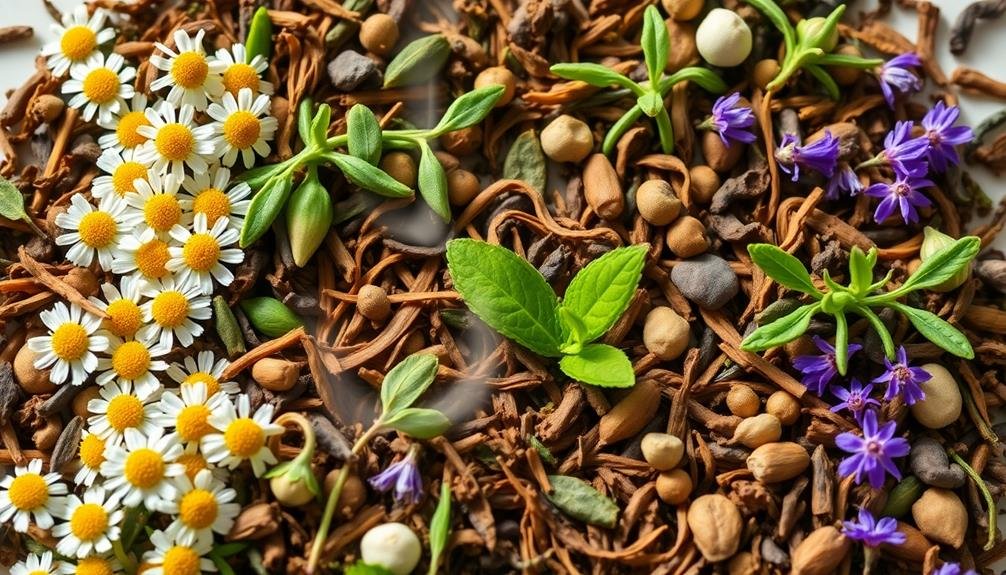
While exploring the world of herbal teas, it's essential to understand the flavor profiles of common herbs.
Chamomile offers a sweet, apple-like taste with floral notes, making it perfect for calming blends.
Peppermint provides a cool, invigorating flavor with a slight sweetness, ideal for invigorating teas.
Lavender brings a delicate, floral aroma with a hint of earthiness, often used to add elegance to blends.
Lemon balm offers a bright, citrusy flavor with subtle mint undertones, great for uplifting teas.
Rosemary provides a strong, pine-like taste with a touch of bitterness, often used sparingly in savory blends.
Ginger adds a spicy, warm kick to teas, perfect for digestive blends.
Hibiscus contributes a tart, cranberry-like flavor and vibrant color, ideal for fruity iced teas.
Rooibos offers a nutty, slightly sweet taste with hints of vanilla, making it a great base for many blends.
Lemongrass provides a citrusy, grassy flavor that pairs well with other herbs.
Balancing Sweet and Savory Notes
Understanding the flavor profiles of common herbs sets the stage for creating harmonious tea blends. When balancing sweet and savory notes, you'll want to reflect on how different herbs interact to create a well-rounded flavor experience.
To achieve balance, start with a base herb that has a neutral or mild flavor, such as chamomile or green tea. Then, add sweeter herbs like stevia, licorice root, or cinnamon to introduce a touch of sweetness. For savory notes, incorporate herbs like rosemary, thyme, or sage in small amounts to avoid overpowering the blend.
You can create depth by combining complementary flavors. For example, pair mint with a hint of lemon balm for a revitalizing sweet-tart combination. Or, mix lavender with a touch of fennel for a unique sweet-savory profile.
Don't forget about intensity levels. Use stronger flavors sparingly and adjust ratios to find the perfect balance. Experiment with different proportions until you achieve the desired taste.
Crafting Aromatic Blends
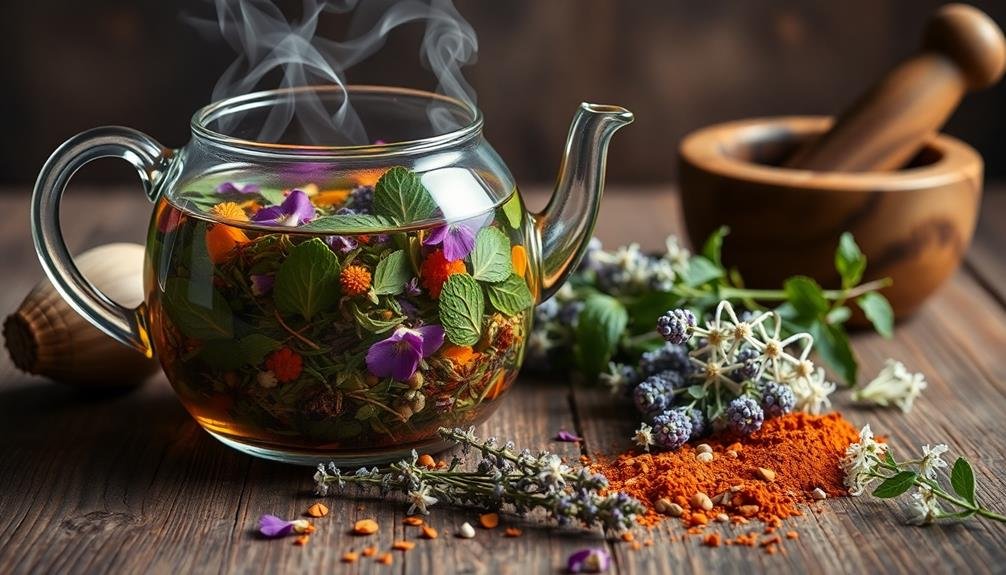
Crafting aromatic blends is an essential skill in creating memorable herbal teas. You'll want to focus on combining herbs that complement each other's scents and flavors. Start by selecting a base herb, such as chamomile or peppermint, which will form the foundation of your blend.
Then, add secondary herbs to enhance the aroma and complexity of your tea. Consider using floral notes like lavender or rose petals to add a delicate fragrance. Citrusy herbs like lemongrass or lemon balm can brighten the blend, while spices like cinnamon or ginger provide warmth and depth.
Don't forget about aromatic leaves like sage or thyme, which can add interesting dimensions to your tea. Experiment with different ratios to find the perfect balance. A general rule of thumb is to use about 60% base herb, 30% secondary herbs, and 10% accent herbs.
Remember that some herbs are more potent than others, so adjust accordingly. You can also incorporate dried fruits or flower buds for visual appeal and added aroma. Always use high-quality, fresh ingredients to guarantee the best possible scent and flavor in your aromatic tea blends.
Seasonal Tea Combinations
As the seasons change, so can your tea preferences.
You'll find spring blends often feature floral and fresh notes, while summer combinations lean towards cool and invigorating flavors.
When fall and winter arrive, you might crave warm and comforting tea blends to match the colder weather.
Spring: Floral and Fresh
Welcoming spring with a cup of floral and fresh tea can be a delightful way to embrace the season's renewal. As nature awakens, you'll want to craft tea blends that capture the essence of blooming flowers and new growth.
Start with a light green tea base, which provides a clean, grassy foundation for your spring-inspired combinations.
For a classic floral blend, pair chamomile with lavender and a hint of rose petals. This combination offers a soothing, aromatic experience that's perfect for calm mornings or evening relaxation.
If you're looking for something more invigorating, try mixing jasmine green tea with lemon verbena and a touch of mint. This revitalizing blend will awaken your senses and provide a burst of energy.
Don't forget to experiment with fruit-infused teas for a taste of spring's bounty. Combine white tea with strawberry leaves and a sprinkle of elderflower for a delicate, sweet flavor.
For a bolder option, mix oolong tea with orange blossom and a dash of ginger to create a complex, zesty brew that'll invigorate your palate and celebrate the season's vibrant energy.
Summer: Cool and Invigorating
When the heat of summer arrives, your tea preferences naturally shift towards cool and invigorating blends. To beat the summer heat, consider crafting revitalizing iced tea combinations that'll quench your thirst and energize your senses.
Start with a base of green tea, known for its cooling properties. Add a handful of fresh mint leaves for a burst of coolness and pair it with cucumber slices for a spa-like experience. For a fruity twist, infuse your tea with sliced peaches or nectarines, which complement the green tea's grassy notes.
If you're looking for a caffeine-free option, try a hibiscus-based blend. Its tart flavor pairs well with lemongrass and a touch of ginger, creating a vibrant and zesty iced tea. For a tropical vibe, mix hibiscus with pineapple chunks and coconut water.
Don't forget about classic black tea. Cold-brew it overnight and add a splash of lemon juice and honey for a revitalizing southern-style sweet tea. Alternatively, combine it with fresh berries and a sprig of basil for a sophisticated summer sipper.
Fall/Winter: Warm and Comforting
The crisp air and falling leaves signal it's time to cozy up with warm, comforting tea blends. As the temperature drops, you'll want to reach for herbs and spices that provide warmth and nourishment. Cinnamon, ginger, and cloves are excellent additions to your fall and winter teas, offering both flavor and potential health benefits.
For a classic autumn blend, try combining black tea with cinnamon and a touch of orange peel. This aromatic mixture will fill your home with the scents of the season. If you're looking for something more indulgent, create a chai-inspired blend using black tea, cardamom, cinnamon, ginger, and a hint of black pepper.
For those chilly winter nights, consider these cozy combinations:
- Peppermint, cocoa nibs, and vanilla bean for a dessert-like treat
- Rooibos, honeybush, and cinnamon for a caffeine-free warming option
- Chamomile, lavender, and lemon balm for a soothing bedtime blend
Don't be afraid to experiment with different ratios and ingredients to find your perfect fall and winter tea combinations. The key is to balance bold, warming flavors with soothing herbs that comfort both body and soul.
Herbal Pairings for Health Benefits
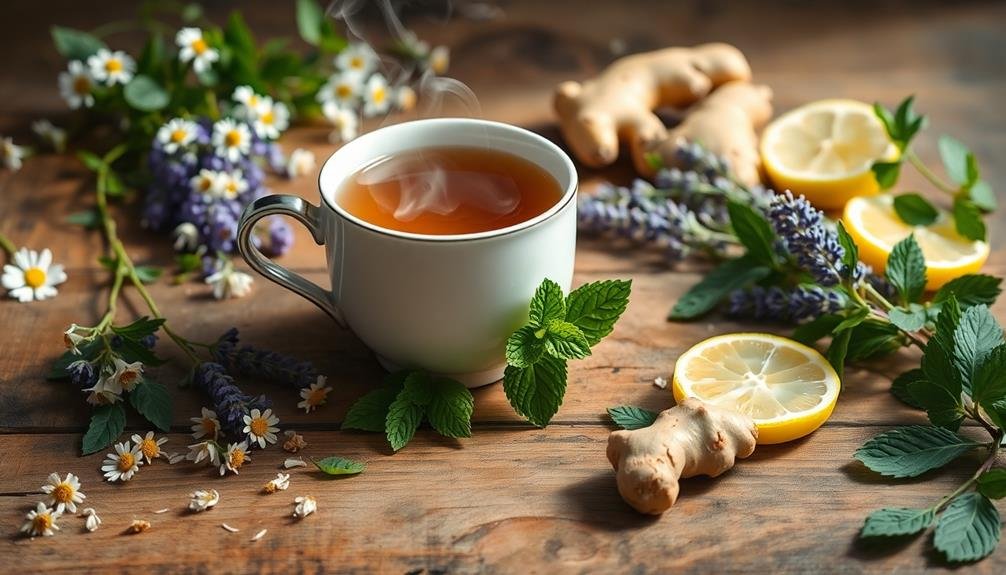
Beyond delightful flavors, herbal tea combinations can offer impressive health benefits. You'll find that pairing certain herbs can amplify their therapeutic effects, creating powerful blends for your well-being.
For instance, combine chamomile with lavender to enhance relaxation and improve sleep quality. If you're looking to boost your immune system, mix echinacea with elderberry for a potent defense against colds and flu.
To aid digestion, try blending peppermint with ginger. This combination soothes upset stomachs and reduces bloating. For inflammation relief, pair turmeric with black pepper; the latter enhances the absorption of curcumin, turmeric's active compound.
If you're seeking to lower stress levels, blend holy basil (tulsi) with lemon balm for a calming effect on both mind and body.
For women's health, consider combining red raspberry leaf with nettle to support reproductive wellness. To improve cognitive function, mix rosemary with ginkgo biloba. This duo enhances memory and concentration.
Experimenting With Unusual Flavor Combinations
You'll find endless possibilities when you venture beyond traditional tea blends.
Try pairing unexpected herbs like lavender with rosemary or mint with fennel for surprising and delightful flavors.
Don't hesitate to infuse your teas with exotic spices such as cardamom, star anise, or even a pinch of saffron to create truly unique taste experiences.
Unexpected Herbal Pairings
Occasionally, the most enchanting tea blends emerge from unlikely combinations.
You'll find that pairing herbs with contrasting flavors can create a harmonious and intriguing cup. Don't be afraid to mix sweet and savory, or floral and earthy notes. For instance, try blending lavender with rosemary for a unique, aromatic experience that balances relaxation with mental clarity.
Consider these unexpected herbal pairings:
- Chamomile and fennel: The sweet, apple-like flavor of chamomile complements fennel's licorice notes, creating a soothing blend that aids digestion.
- Lemon balm and nettle: Combine the bright, citrusy taste of lemon balm with nettle's earthy undertones for a revitalizing and nutrient-rich infusion.
- Peppermint and sage: This pairing offers a cool, minty flavor with sage's savory depth, resulting in a tea that's both invigorating and grounding.
When experimenting with these combinations, start with equal parts of each herb and adjust to your taste preferences.
You'll discover that unexpected pairings can lead to delightful new flavors, expanding your tea repertoire and offering unique sensory experiences.
Exotic Spice Infusions
For tea enthusiasts seeking to push the boundaries of flavor, exotic spice infusions offer a world of exciting possibilities. You'll discover unique taste profiles by incorporating spices from different cultures into your tea blends.
Start with familiar spices like cinnamon, cardamom, and ginger, then venture into more exotic territory.
Try adding a pinch of saffron to your green tea for a luxurious golden hue and subtle floral notes. Experiment with star anise in black tea for a licorice-like sweetness, or infuse your oolong with fennel seeds for a rejuvenating, anise-like flavor.
Don't shy away from savory spices either; a touch of cumin or coriander can add depth to herbal blends.
For a truly adventurous cup, consider using lesser-known spices like grains of paradise, which impart a peppery, citrusy kick. Sumac's tart, lemony flavor can brighten up fruit teas, while long pepper's complex heat adds intrigue to chai blends.
Remember to start with small amounts and adjust to taste, as some spices can quickly overpower delicate tea flavors. With patience and creativity, you'll craft unique, exotic tea blends that tantalize your taste buds.
Enhancing Teas With Dried Fruits
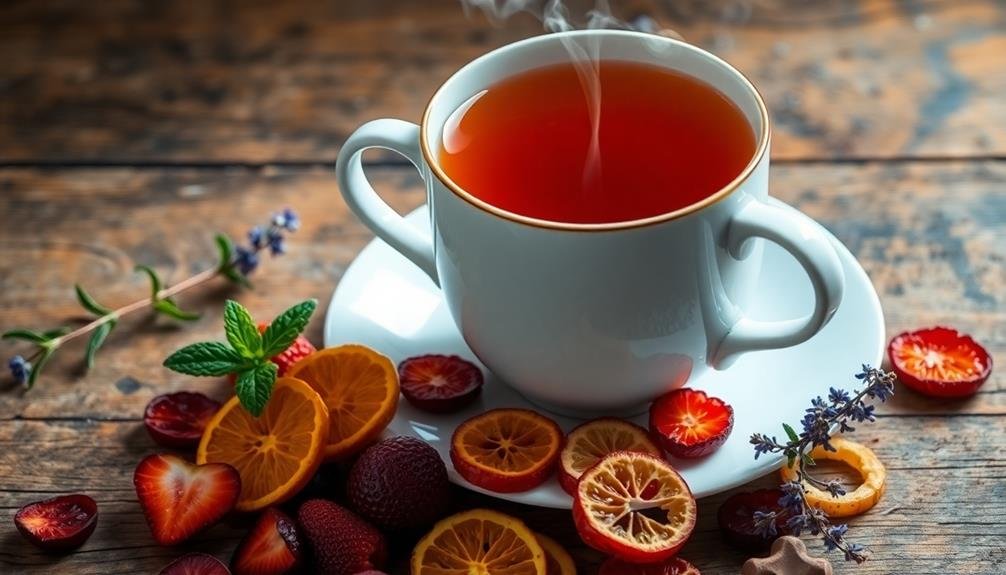
Dried fruits bring out the best in many teas, adding depth and natural sweetness to your brew. You'll find that these dehydrated delights can transform a simple cup into a complex, flavorful experience.
When choosing dried fruits for your tea, opt for unsweetened varieties to avoid overpowering the natural tea flavors. Popular dried fruit additions include apple, citrus peels, berries, and tropical fruits like mango or pineapple. Each brings its unique character to the mix. For example, dried apple pairs wonderfully with cinnamon-spiced teas, while citrus peels complement green and white teas beautifully.
To enhance your tea with dried fruits, try these methods:
- Steep the fruits directly with your loose-leaf tea
- Create a fruit-infused simple syrup to sweeten your tea
- Garnish your cup with rehydrated fruit pieces for visual appeal and flavor
Remember that a little goes a long way. Start with small amounts and adjust to taste.
You'll soon discover your perfect fruit and tea pairings, opening up a world of exciting flavor possibilities. Don't be afraid to experiment with different combinations to find your personal favorites.
Mastering the Art of Layering
Layering flavors in tea is like composing a symphony, with each ingredient playing a crucial role in the final harmony. To master this art, you'll need to understand the nuances of different herbs, spices, and botanicals.
Start by selecting a base tea, such as black, green, or white, which will serve as your foundation. Then, add your primary flavoring agent – this could be a strong herb like peppermint or a bold spice like cinnamon.
Next, introduce secondary flavors that complement or contrast with your primary ingredient. For example, pair lavender with chamomile for a soothing blend, or add a touch of ginger to a citrusy mix for a spicy kick.
Don't forget to evaluate the mouthfeel; ingredients like rose petals can add a silky texture, while lemongrass provides a rejuvenating crispness.
Creating Signature Tea Blends
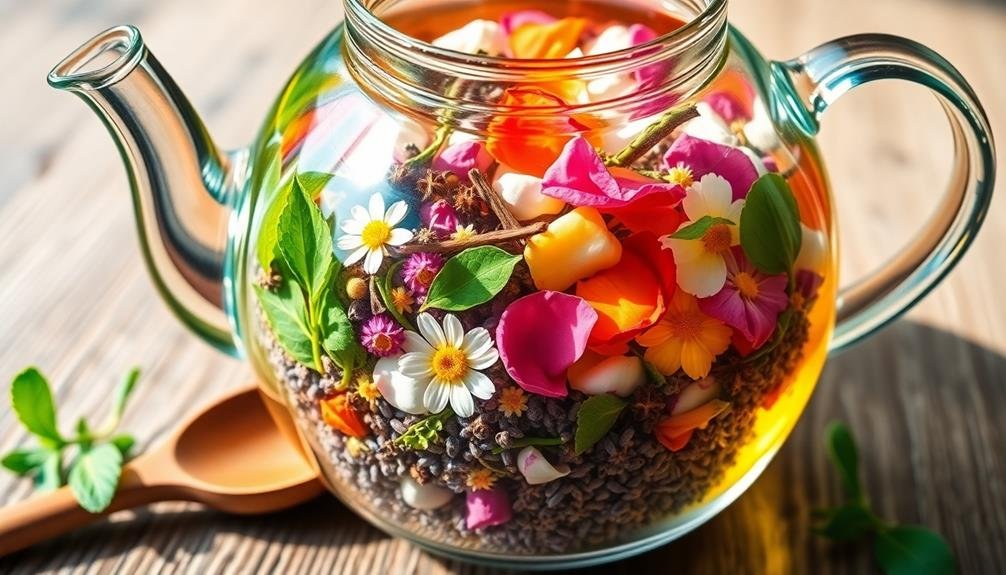
In light of your newfound layering skills, it's time to commence creating your own signature tea blends. Start by selecting a base tea, such as black, green, or white, which will serve as the foundation for your blend.
Next, consider the flavor profile you're aiming for and choose complementary herbs, spices, or fruits to enhance the base tea's characteristics.
Experiment with different ratios and combinations, keeping detailed notes on each attempt. You'll want to record:
- The exact measurements of each ingredient
- Steeping time and water temperature
- Tasting notes and overall impressions
Don't be afraid to think outside the box and try unexpected pairings. You might discover a unique blend that becomes your personal favorite or even a hit among friends and family.
Remember that creating a signature blend is an iterative process, so be patient and willing to make adjustments as you go. With practice and persistence, you'll develop a keen sense for which flavors work well together and how to achieve the perfect balance in your custom tea creations.
Frequently Asked Questions
How Long Should Herbal Tea Blends Steep for Optimal Flavor?
You'll want to steep herbal tea blends for 5-10 minutes. It's best to start with 5 minutes, then taste and adjust. Don't steep too long, or you'll risk bitterness. Experiment to find your perfect flavor.
Can I Use Fresh Herbs Instead of Dried Ones in Tea Blends?
Yes, you can use fresh herbs in tea blends. They'll provide a vibrant flavor, but you'll need to use more than dried herbs. Remember, fresh herbs have higher water content, so adjust your steeping time accordingly.
What's the Best Way to Store Homemade Herbal Tea Blends?
Store your homemade herbal tea blends in airtight containers away from light, heat, and moisture. You'll want to keep them in a cool, dark place. Don't forget to label them with ingredients and dates for freshness.
Are There Any Herbs That Should Never Be Combined in Tea?
You shouldn't mix certain herbs due to potential interactions. Avoid combining St. John's Wort with other medications, and don't mix stimulating herbs like caffeine with sedatives. Always research herb combinations and consult a healthcare professional before experimenting.
How Can I Adjust Tea Blends for Iced Tea Versus Hot Tea?
You'll want to adjust your tea blends for iced tea by increasing the strength. Use more tea leaves or steep longer for cold brewing. For hot tea, stick to regular proportions. Remember, flavors intensify as they cool.
In Summary
You've now explored the art of herbal tea blending, from understanding flavor profiles to creating unique combinations. Remember, there's no right or wrong in crafting your perfect cup. Trust your palate and don't be afraid to experiment. Whether you're seeking health benefits, seasonal flavors, or simply a delightful aroma, you're equipped to create your own signature blends. Keep exploring, tasting, and refining your tea-making skills. The world of herbal harmony awaits your personal touch.


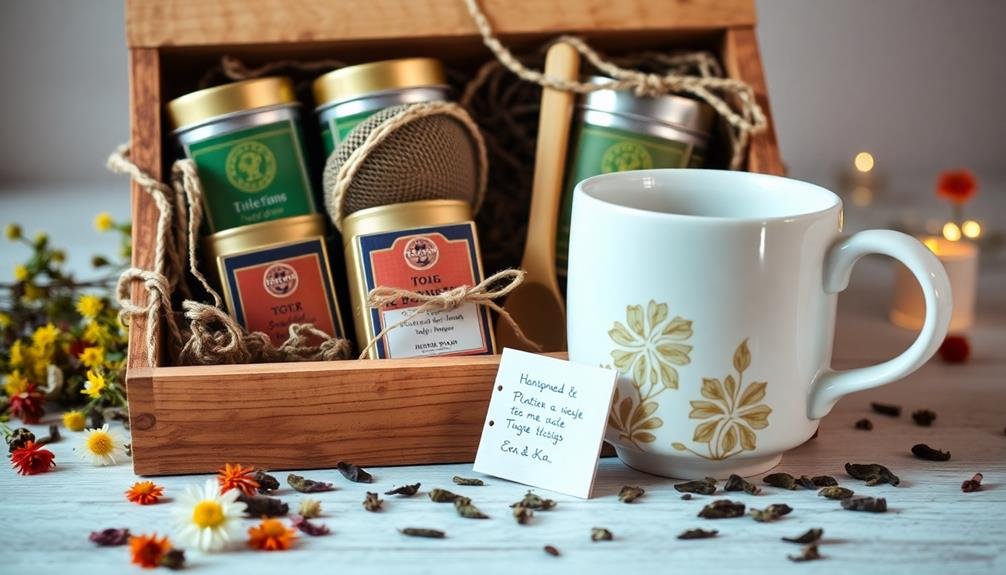
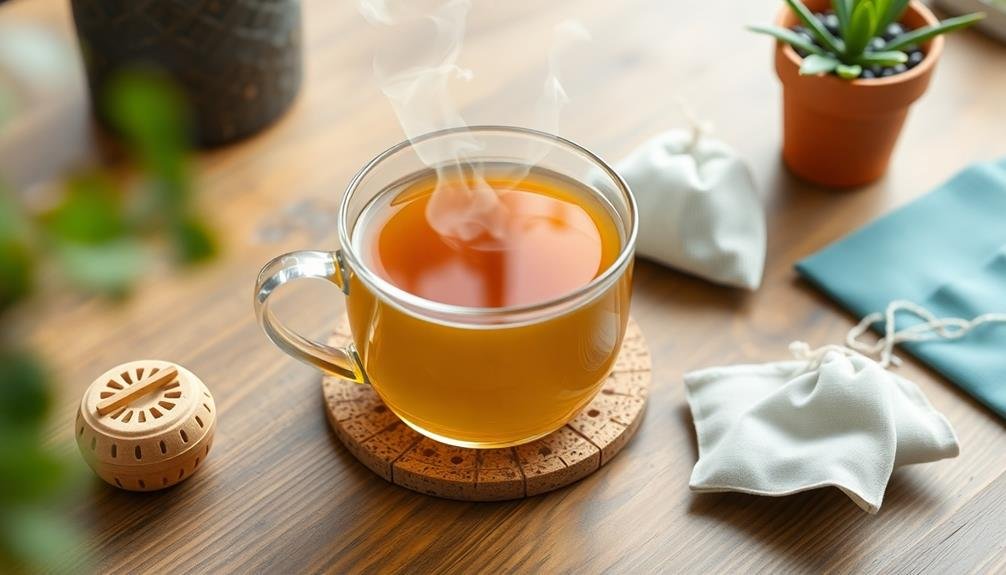
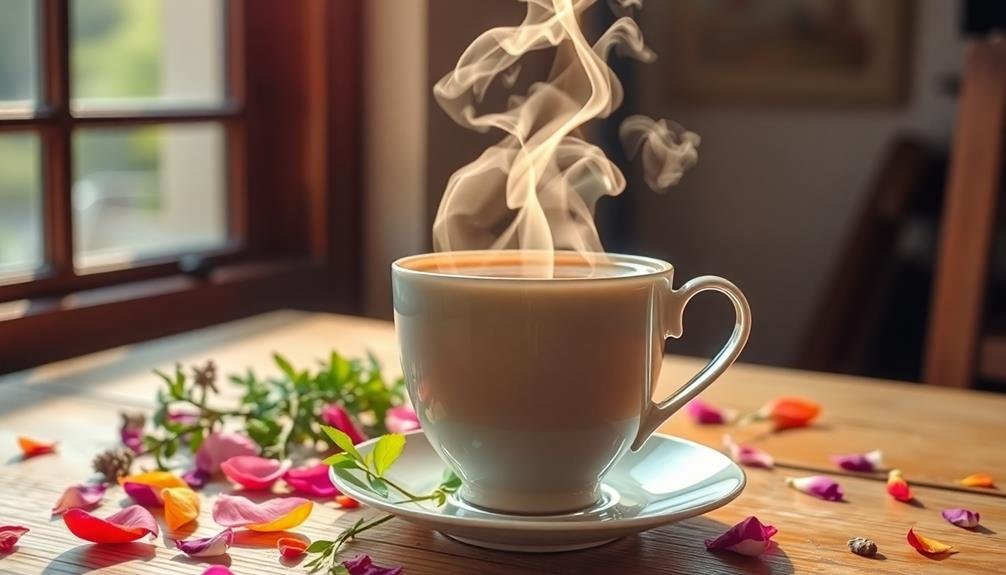
Leave a Reply